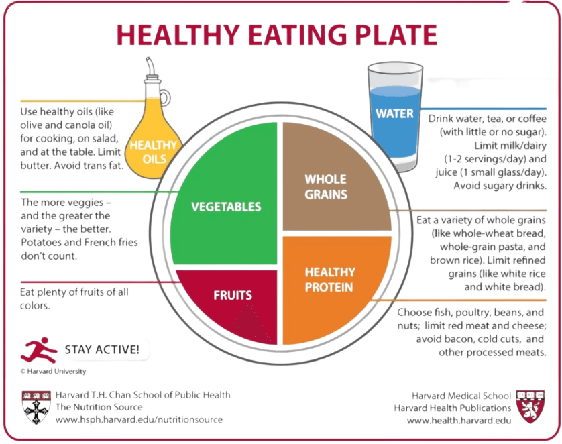Introduction to carbohydrates
Carbohydrates are a major macronutrient and one of your body’s primary sources of energy. Most information labels and discourages eating carbs with the notion of “Carbs are bad”, but the key is finding the right carbs, not avoiding them altogether.
You may have heard that eating complex carbs is better than simple carbs. But nutrition labels don’t always tell you if the carbohydrate content is simple or complex. Understanding how these foods are classified and how they work in your body can help you make the right decision for your body.
Carbohydrates are made up of three components: fibre, starch, and sugar. Fibre and starch are complex carbs, while sugar is a simple carb. Depending on how much of each of these is found in food determines its nutrient quality.
Types – Simple and Complex Carbs

What are Simple Carbs?
Simple carbs are sugars.
While some of these occur naturally in milk, most of the simple carbs are added to foods. Standard simple carbs added to foods include:
- raw sugar
- brown sugar
- corn syrup and high-fructose corn syrup
- glucose, fructose, and sucrose
- fruit juice concentrate
What are Complex Carbohydrates?
Complex carbs pack in more nutrients than simple carbs and they are healthy.
They’re higher in fibre and digest more slowly, thereby making you feel satiated. Complex carbs are a great option for weight control. They’re also optimum for people with type 2 diabetes because they help regulate blood sugar spikes after meals.
Fibre and starch are the two types of complex carbohydrates. Fibre is essential because it promotes bowel regularity and helps to control cholesterol.

The primary sources of dietary fibre include:
- Fruits
- Vegetables
- Nuts
- Beans
- Whole grains
Starch is also found in some of the same foods as fibre. The difference is certain foods are considered more starchy than fibrous, such as potatoes.
Complex carbohydrates are key to long-term health. They make it easier to maintain a healthy weight and can even help guard against type 2 diabetes and cardiovascular problems in the future.
Glycemic Index
Glycemic index (GI) measures how much a type of food increases your blood sugar levels. The higher the GI, the greater the effect on blood sugar levels. It is a tool that’s often used to promote better blood sugar management. Several factors influence the glycemic index, including its nutrient composition, cooking method, ripeness, and how processed the food is.
GI can help increase your awareness of what you’re putting on your plate, enhance weight loss, decrease your blood sugar levels, and reduce your cholesterol.
Foods high in processed carbs and sugar are digested quickly and often have a high GI, while foods high in protein, fat, or fibre usually have a low GI.
Foods that are carb-less are not assigned a GI and include meat, fish, poultry, nuts, seeds, herbs, spices, and oils.
- Low GI: 55 or less
- Medium GI: 56–69
- High GI: 70 or above
Keep in mind that the glycemic index is different from the glycemic load (GL). Unlike the GI, which doesn’t consider the amount of food eaten, the GL factors in the number of carbs in a food serving to determine how it may affect blood sugar levels.
For this reason, it’s crucial to take both the glycemic index and glycemic load into consideration when selecting foods to help support healthy blood sugar levels. Simple carbs have a higher glycemic index than complex carbs, although several complex carbs also have a moderate to high glycemic level.

What Are The Benefits of Complex Carbs?
1.Promotes Muscle Growth
Protein is vital for building muscle; likewise, the presence of carbs is as significant to optimise growth and recovery. Eating post-workout replenishes glycogen stores and puts the body in an anabolic state, or essentially the process of building muscle.
2.Sustains Energy
Glucose provided by carbs is your body’s preferred source of energy. Rather than consuming simple sugars that cause blood sugar to spike, it is recommended to consume complex carbs that burn slower in the system and sustain fuel for longer.
3.Manages Weight
High-fibre foods are generally low in calories and tend to be more filling than non-fibre foods. The combination of low-calorie and satiety may facilitate weight loss or regulate weight.
4.Brain Health
The brain uses carbs as fuel, and if devoid of carbs, you might feel light-headed and irritable, along with having a difficult time concentrating and focusing.
Furthermore, fibre-rich whole grains have been linked to reduced cognitive impairments. In contrast, the folate found in oats and other whole grains is crucial for proper brain development and function, ultimately supporting mental health and well-being.
Antioxidants and other vitamins and minerals supplied by complex carbs are protective against dementia and Alzheimer’s disease.

5.Regulates Blood Sugars
The gentle absorption of complex carbs helps keep blood sugar levels sustained and steady, whereas simple carbs ignite quick energy that may spike blood sugars, only to drop them very quickly shortly after.
6.Backs Digestive Health
The fibre found in complex carbs promotes bowel health and regularity, especially thanks to “bulk-forming” insoluble fibre sources found in fibrous veggies, nuts, and fruits that bear tougher skin. Diets rich in fibre have also been shown to protect from colon diseases, haemorrhoids, and colorectal cancer.
7.Reduces Mortality Risk
A recent meta-analysis including over 400,000 participants found elevated mortality (death) risk for people who followed high-carbohydrate diets and low-carb diets.
Diets that provide 50 to 55 per cent of total energy from carbohydrates were associated with lower mortality risk, with substitution of plant-based proteins for carbs further reducing mortality risk.
Rather than dramatically dropping carb intake or significantly increasing them, balance the meal plate with lean proteins and healthy fat sources. Doing so is a surefire approach to ensure the body is receiving the nutrients it requires, along with promoting longevity.
Here’s a recommendation by Harvard of how your plate should look:

Best Sources of Complex Carbs and Fibre
- Whole Grains: wheat, oats, brown rice, quinoa, millet, rye, farro, quinoa, barley, along with whole-grain bread, cereals, and flours
- Beans and Legumes: lentils, soybeans, peas, peanuts, chickpeas, and beans, including black, kidney, and pinto
- Nuts and Seeds: almonds, cashews, pecans, chia and flax seeds, quinoa, walnuts
- Starchy Vegetables: beets, butternut squash, carrots, corn, russet potatoes, sweet potatoes, pumpkin, yams, zucchini
- Fibre-Rich Vegetables: broccoli, cauliflower, onions, spinach, peppers, tomatoes, and green, leafy veggies such as kale, spinach, and lettuce
- Fibre-Rich Fruits: bananas, oranges, blueberries, raspberries, strawberries, fruits with the skin such as apples and pears
Conclusion
Carbohydrates are an essential energy source for the body, and Complex carbohydrates provide a lasting energy source compared to simple carbohydrates because they take longer to digest.
However, this does not mean that all complex carbohydrates are healthier choices. Simple carbohydrates are present in many healthful foods, such as fruits and milk. Complex carbohydrates may also be a constituent of refined foods, such as white bread or white rice. For these reasons, it is essential to consider the whole food rather than just the type of carbohydrate it contains.
References
- https://www.hsph.harvard.edu/nutritionsource/healthy-eating-plate/
- https://www.healthline.com/health/food-nutrition/simple-carbohydrates-complex-carbohydrates
- https://www.bistromd.com/nutrition/7-benefits-of-complex-carbohydrates-and-the-best-ones-to-add-to-your-diet
- https://www.healthline.com/nutrition/glycemic-index#low-glycemic-diet








